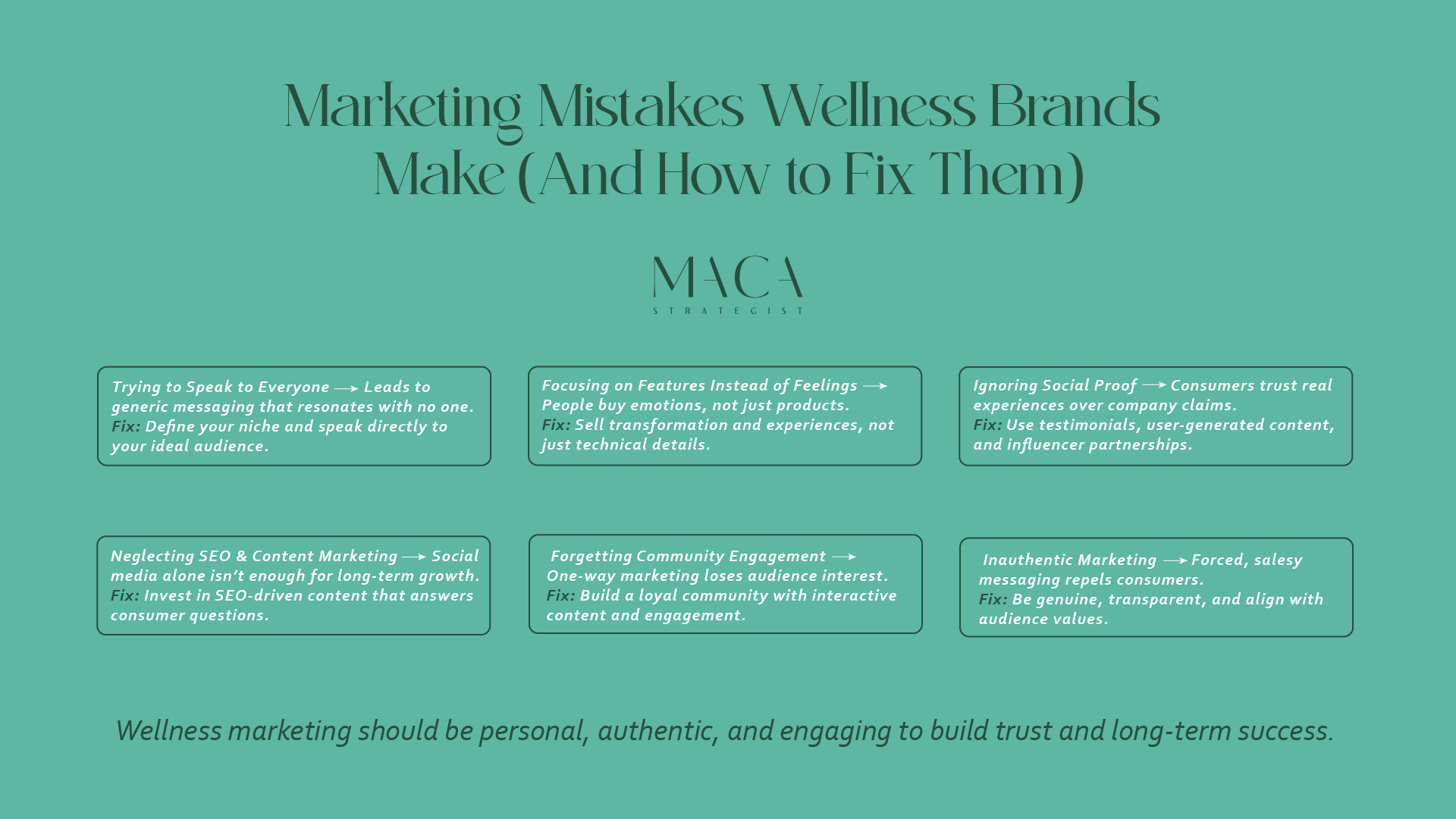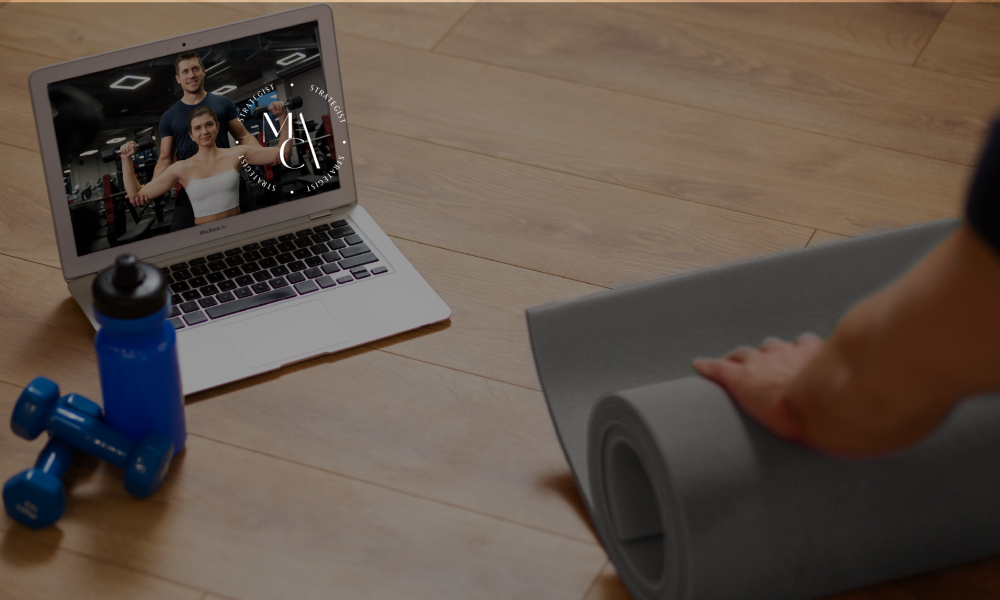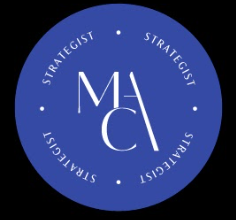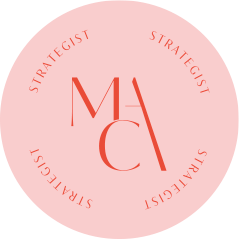The wellness industry is full of incredible brands—businesses built on passion, purpose, and a commitment to helping people live healthier lives. But even the best wellness brands can struggle when it comes to marketing that truly connects with their audience.
Why? Because marketing wellness isn’t like selling sneakers or tech gadgets. Wellness is deeply personal. People aren’t just buying a product or service—they’re investing in their health, their happiness, and their future. That means the usual marketing tricks won’t cut it. Consumers want brands they can trust, messages that speak directly to them, and marketing that feels genuine, not salesy.
That’s where many brands go wrong.
Too often, wellness businesses fall into the trap of generic messaging, forgettable branding, and disconnected marketing strategies. They try to appeal to everyone—and end up resonating with no one. They focus on selling products, when they should be selling experiences, transformations, and a lifestyle.
But here’s the good news: these mistakes can be fixed.
With the right approach, any wellness brand—whether it’s a boutique fitness studio, a holistic skincare company, or a digital health platform—can create marketing that inspires, engages, and converts.
What You’ll Learn in This Blog
✅ The biggest marketing mistakes that hold wellness brands back.
✅ Real-world examples of brands that turned their strategies around.
✅ Actionable solutions to help you build a marketing strategy that feels authentic and powerful.
At MACA Strategist, we believe wellness marketing should feel as good as the products and services you offer. That’s why we’ve put together this guide—to help wellness brands stop spinning their wheels and start building marketing strategies that truly work.
✨ Let’s dive in and make sure your wellness brand is seen, heard, and loved by the right audience.
Why Great Wellness Brands Struggle with Marketing
The wellness industry has never been more exciting—or more competitive. From organic skincare to virtual fitness programs, consumers have more wellness options than ever before. Yet, many brands still struggle to make real connections with their audience.
But why?
Because wellness is personal, and marketing must be, too. People aren’t just looking for products—they’re searching for solutions that fit their unique needs. When brands rely on generic messaging, pushy sales tactics, or disconnected strategies, they fail to inspire trust, loyalty, or engagement.
Common Struggles Wellness Brands Face
💡 1. The Wellness Market is Crowded
There are countless wellness brands out there. If your marketing doesn’t clearly communicate what makes your brand unique, you risk blending into the noise. According to McKinsey & Company, 50% of wellness consumers prefer brands that offer personalized solutions over generic ones. If your messaging feels too broad, you’re missing a huge opportunity.
💡 2. People Crave Trust, Not Just Hype
Consumers are more skeptical than ever. They can spot inauthentic marketing a mile away. A survey by Edelman Trust Barometer found that 81% of people need to trust a brand before making a purchase. If your marketing is too promotional, lacks transparency, or feels disconnected from your audience’s real concerns, it won’t build that trust.
💡 3. Salesy Marketing Pushes People Away
Many wellness brands fall into the trap of focusing too much on the product and not enough on the experience. Consumers don’t just want to know what your product is—they want to know what it can do for them. Harvard Business Review reports that brands that create emotional connections see higher loyalty and engagement. If your messaging doesn’t tap into real emotions, it won’t inspire action.
The Fix: A Consumer-Focused Approach
Instead of selling, focus on serving.
Instead of shouting louder, speak more clearly.
Instead of marketing to everyone, connect deeply with the right audience.
In this post, we’ll break down the biggest marketing mistakes wellness brands make—and give you expert-backed strategies to fix them. Because when you get your marketing right, your brand won’t just grow—it will thrive.

Trying to Speak to Everyone (and Resonating with No One)
Imagine walking into a wellness store where every product is labeled simply: “For Better Health.” No details, no differentiation—just a vague promise of feeling good. Would you trust it? Would you buy anything?
That’s exactly what happens when wellness brands try to speak to everyone with broad, one-size-fits-all messaging. Instead of creating real connections, they fade into the background, lost in a sea of generic wellness claims.
🚨 The Mistake: Casting a Wide Net and Losing Engagement
Many wellness brands make the mistake of trying to appeal to everyone with messaging that lacks specificity. They use phrases like:
❌ “Live healthier today!”
❌ “Feel your best with our wellness solutions.”
❌ “A holistic approach to better living.”
While these statements sound nice, they don’t speak to anyone in particular. A fitness enthusiast, a busy parent dealing with burnout, and someone seeking holistic healing all have very different needs. If your brand doesn’t directly address their concerns, they’ll move on to one that does.
According to NY wellness marketing experts, successful brands don’t try to be everything to everyone—they focus on the right audience and tailor their message to speak their language.
💡 The Fix: Niche Down and Speak Directly to Your Ideal Customer
🔹 Identify Your Core Audience
Instead of marketing to all wellness consumers, define who your brand serves best. Are you targeting:
- Busy professionals seeking stress relief?
- Holistic health seekers looking for natural remedies?
- Athletes needing high-performance recovery solutions?
Each audience has different pain points, and your marketing should speak directly to them.
🔹 Use Personalization to Make a Real Connection
People don’t just want wellness solutions—they want ones that fit their unique journey. Wellness brands that use personalized messaging, targeted content, and niche branding see higher engagement, trust, and conversions.
🔹 Leverage PR to Strengthen Your Brand Identity
Partnering with an NY wellness PR agency can help wellness brands craft messaging that feels authentic and targeted. Instead of sounding like every other brand, your PR strategy can ensure your story resonates with the right audience in the right way.
Case Study: The Power of Niche Marketing
A wellness retreat was struggling with low engagement because they marketed themselves as a “one-stop destination for relaxation and healing.” Their messaging was too broad, and potential clients didn’t feel a personal connection.
✔️ What they changed: They rebranded as a stress-relief retreat for high-achieving professionals facing burnout.
✔️ The result? Website traffic doubled, engagement rates skyrocketed, and bookings increased by 60%—all because they spoke directly to the right audience.
Focusing on Features Instead of Feelings
Think about the last time you bought something wellness-related. Did you choose it because of its scientific formulation, or because it promised to help you feel calmer, sleep better, or wake up energized?
Consumers don’t just buy wellness products—they buy solutions to their problems and feelings of transformation. Yet, many wellness brands make the mistake of leading with features instead of emotions, overwhelming potential customers with technical jargon and product specs instead of showing them why it matters.
🚨 The Mistake: Too Much Tech, Not Enough Emotion
Many wellness brands focus on what their product does but forget to connect with how it makes people feel. They say:
❌ “Our supplement contains adaptogens and bioactive compounds.”
❌ “This program includes 12 guided meditation sessions.”
❌ “Our fitness app uses advanced AI for optimized workout routines.”
While these statements provide useful information, they don’t spark an emotional connection. According to Harvard Business Review, brands that connect emotionally with consumers see higher customer loyalty and engagement than those that rely purely on facts.
Another study by Psychology Today confirms that emotions drive purchasing decisions far more than logic—people buy based on feelings and then justify their choices with logic.
💡 The Fix: Sell a Feeling, Not Just a Product
🔹 Tell a Story That Resonates
Instead of just listing benefits, create a narrative that makes customers feel seen and understood. Example:
❌ “Our herbal tea blend contains chamomile and valerian root.”
✔️ “Imagine unwinding after a long day, sipping a warm cup of herbal tea that melts away stress and prepares your mind for deep, restful sleep.”
🔹 Use Emotional Branding
Wellness marketing should evoke emotions—whether it’s relaxation, empowerment, transformation, or healing. According to Forbes, brands that focus on emotional storytelling see higher engagement and brand loyalty.
🔹 Make Your Marketing Experience-Driven
Instead of just selling a wellness retreat, sell the experience:
❌ “We offer a three-day wellness retreat with yoga, meditation, and organic meals.”
✔️ “Step into a peaceful sanctuary where stress fades away, your body recharges, and you rediscover balance—guided by expert healers in a breathtaking natural setting.”
Case Study: How Storytelling Increased Wellness Retreat Bookings
A wellness retreat was struggling to fill its programs despite offering top-tier amenities and expert-led sessions. Their marketing focused on features—listing out daily schedules and accommodations—but failed to capture the emotional transformation guests would experience.
✔️ The Change: They rewrote their marketing copy to focus on the journey—how guests would feel after attending, using personal testimonials and vivid storytelling.
✔️ The Result: A 40% increase in bookings and stronger customer engagement, as people began to see themselves in the experience.
Neglecting the Power of Social Proof
Would you trust a wellness brand that only talks about how great it is? Probably not.
That’s because people don’t just believe brands—they believe people. They trust the experiences of real customers, the recommendations of influencers they admire, and the social proof that shows a product actually works.
Yet, many wellness brands make the mistake of relying solely on product descriptions and company claims, failing to showcase the voices that matter most: their customers.
🚨 The Mistake: Ignoring the Influence of Real People
A brand can claim its supplement promotes better sleep, its skincare line delivers radiant skin, or its wellness retreat offers life-changing experiences—but without proof, these claims mean little. Consumers have become skeptical of marketing messages that sound too good to be true.
🔹 72% of people say they trust online reviews just as much as personal recommendations. (BrightLocal, 2023)
🔹 User-generated content (UGC) is 2.4x more likely to be seen as authentic compared to brand-created content. (Business Insider)
🔹 Influencer recommendations drive 49% of consumers to make a purchase. (Digital Marketing Institute)
The takeaway? Customers trust each other more than they trust you. If your wellness brand isn’t actively showcasing real experiences, testimonials, and success stories, you’re missing a major opportunity.
💡 The Fix: Let Your Customers Speak for You
✅ Feature Authentic User-Generated Content
Encourage customers to share their journey with your brand. Whether it’s before-and-after photos, video testimonials, or personal stories, these real-life experiences validate your brand’s claims.
🔹 Post customer transformations on Instagram stories.
🔹 Highlight glowing testimonials on your website.
🔹 Share social media posts from real users experiencing your product.
✅ Leverage Influencer Partnerships
People follow wellness influencers because they trust their advice. Partnering with aligned, authentic influencers can significantly boost your credibility.
🔹 Work with micro-influencers who genuinely love your brand.
🔹 Offer gifted products or exclusive experiences in exchange for honest reviews.
🔹 Collaborate on Instagram Lives or TikTok videos to share real-time experiences.
Case Study: How a Skincare Brand Used Social Proof to Skyrocket Sales
A wellness skincare brand was struggling to convert visitors into customers. Their website had polished product descriptions, but no real proof of effectiveness.
✔️ The Fix: They launched a campaign showcasing real users’ skin transformations through before-and-after pictures, customer interviews, and influencer testimonials.
✔️ The Result? A 78% increase in conversions—because people saw real results from real customers.
Underestimating the Role of SEO & Content Marketing
Imagine having a life-changing wellness product or service, but no one can find it. You’re putting in the effort—posting on social media, running ads—but your audience isn’t growing, and your website traffic is low.
This is what happens when wellness brands underestimate the power of SEO and content marketing.
Social media and paid ads are valuable, but they’re temporary—when the budget runs out or the algorithm changes, visibility drops. SEO-driven content marketing, on the other hand, builds long-term, organic traffic that keeps bringing potential customers to your brand.
Yet, many wellness businesses neglect this, either because they don’t see results fast enough or they don’t know where to start.
🚨 The Mistake: Ignoring SEO & Content Strategy
Many wellness brands fall into the trap of:
❌ Relying only on social media & paid ads – These can generate short-term interest but don’t establish long-term credibility or organic reach.
❌ Writing broad, unfocused blog content – Posts that don’t address specific consumer questions fail to rank on search engines and don’t engage the audience.
❌ Inconsistent content creation – Posting sporadically or without a strategy makes it hard to build trust and visibility.
The result? Lost traffic, lower credibility, and missed opportunities to connect with wellness consumers searching for solutions.
According to HubSpot, businesses that prioritize blogging are 13x more likely to see a positive ROI. And 75% of users never scroll past the first page of Google (Forbes), meaning if your content isn’t SEO-optimized, you’re invisible to potential customers.
💡 The Fix: Invest in SEO-Optimized, Value-Driven Content
To grow organically and become a trusted wellness resource, brands must:
✅ Create content that people are already searching for.
People turn to Google when they need wellness advice. Instead of guessing what your audience wants, use keyword research tools to find questions they’re actively asking.
📌 Example: Instead of a generic blog like “The Benefits of Holistic Health”, create a search-friendly post like “How Can I Naturally Improve Gut Health?” or “Best Morning Routines for Stress Relief.”
✅ Optimize for search engines, but write for humans.
SEO matters, but content should feel engaging and informative—not robotic. Make sure your blogs include:
- Headlines that capture attention
- Well-structured, easy-to-digest sections
- Internal and external links to credible sources
✅ Be consistent.
Posting once a month won’t cut it—Google rewards fresh, updated content. Whether it’s blogs, guides, or FAQs, consistency builds authority over time.
Case Study: How SEO Helped a Wellness Brand Build a Loyal Following
A wellness coaching business struggled to attract organic leads. They were too reliant on social media, and when engagement dropped, so did their sales.
✔️ The Fix: They worked with NY wellness marketing experts to create a long-term SEO and content marketing strategy.
✔️ Strategy: They published weekly blog posts answering common wellness-related search queries and optimized their website with local SEO tactics.
✔️ The Result? A 300% increase in organic website traffic and a steady flow of new leads—all without relying on paid ads.
Ignoring Community & Engagement
Imagine walking into a wellness event where a brand is on stage, talking nonstop about itself—never asking questions, never listening, never engaging. How long before the audience tunes out?
That’s exactly what happens when wellness brands treat marketing as a one-way broadcast instead of an interactive, community-driven conversation.
Wellness isn’t just about products—it’s about connection. Consumers don’t just want to buy from a brand; they want to belong to one. And yet, many wellness businesses fail to build a loyal community, missing out on the kind of brand advocacy that turns casual buyers into lifelong supporters.
🚨 The Mistake: Talking At Your Audience Instead of With Them
Too many wellness brands focus only on promotion—posting polished ads, announcing sales, or sharing content that feels impersonal. The result? Low engagement, weak brand loyalty, and missed opportunities to create meaningful relationships.
📌 What Happens When You Ignore Engagement?
❌ Your audience feels like just another customer. Wellness is personal—people want real conversations, not corporate messaging.
❌ Your brand becomes forgettable. Without community-driven interactions, you risk being just another brand in a crowded industry.
❌ You lose long-term customers. Studies show that loyalty-driven brands outperform competitors by 2x because engaged customers are more likely to repurchase (Harvard Business Review).
💡 The Fix: Build a Thriving, Engaged Community
✅ Create Engagement-Driven Content
💬 Polls & Interactive Posts – Ask followers what wellness challenges they’re facing and tailor content to their needs.
🎥 Live Q&As & Webinars – Provide real-time value by answering audience questions and hosting expert-led wellness discussions.
📱 Instagram & TikTok Stories – Feature user-generated content, behind-the-scenes moments, and authentic brand interactions.
✅ Foster Community, Not Just Customers
🌿 Facebook Groups & Private Communities – Build a space where customers can connect, share experiences, and support each other.
🏆 Wellness Challenges & Programs – Engage customers through guided wellness journeys that keep them coming back.
🎟 Member-Only Content & Perks – Offer exclusive videos, wellness guides, or VIP product launches to deepen brand loyalty.
According to Forbes, brands that invest in community building see higher engagement, brand trust, and long-term growth.
Case Study: How a Wellness Brand Built a Thriving Community
A holistic nutrition brand struggled with low engagement and retention rates. Despite offering high-quality products, they lacked a sense of community, and customers weren’t sticking around.
✔️ The Fix: They launched a Facebook group for holistic wellness, offering weekly Q&As, nutrition challenges, and a space for customers to share their health journeys.
✔️ Strategy: They encouraged customer-led discussions, making the brand feel like a trusted partner, not just a business.
✔️ The Result? A 70% increase in repeat purchases, a 400% boost in engagement, and a loyal, thriving customer base.
Marketing That Feels Authentic, Not Forced
Wellness is personal. Marketing should be, too.
Consumers don’t want to be sold to—they want to be understood. They’re looking for brands that align with their values, speak their language, and genuinely care about their well-being. Wellness marketing isn’t just about promoting a product or service—it’s about connecting, inspiring, and serving.
So, what separates the brands that thrive from those that struggle?
✨ Authenticity. People can spot forced marketing a mile away. They don’t want fluffy wellness buzzwords—they want real, meaningful content that speaks to their needs.
✨ Engagement. Brands that listen, interact, and build community will always win over those that treat marketing as a one-way broadcast.
✨ Strategy. Throwing content into the digital void without a plan isn’t marketing—it’s guesswork. Successful brands use tailored strategies that align with their audience, niche, and goals.
At MACA Strategist, we specialize in marketing that feels human, not forced. Our team of NY wellness marketing experts helps brands craft high-impact, consumer-focused strategies that drive engagement, build trust, and create lasting growth.
✅ Need a custom marketing plan that speaks directly to your ideal customers? We’ve got you.
✅ Want to refine your brand messaging so it resonates on a deeper level? Let’s do it.
✅ Looking to partner with a NY wellness PR agency to boost credibility and visibility? We’re here to help.
🚀 Are you making any of these common marketing mistakes? Let’s fix them—together. The future of wellness marketing belongs to brands that show up authentically, engage meaningfully, and inspire transformation. Let’s make sure yours is one of them.







